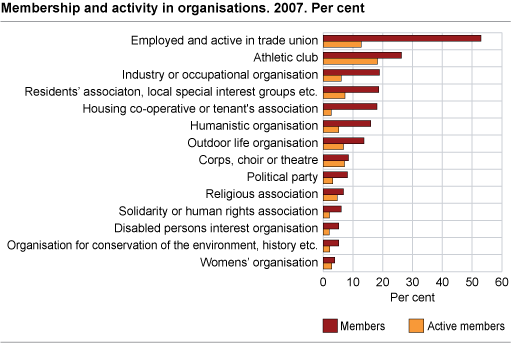Content
Published:
This is an archived release.
Many members, fewer active
The proportion of the population that are members of various organisations has been at about the same level from 1997 to 2007. However, a declining part is active. In 1997, 52 per cent considered themselves active, in 2007 47 per cent.
The Survey of level of living 2007 indicates that some 80 per cent of the population were members of one or more organisations, about at the same level as in 1997, 2001 and 2004. A significant reason for such a high proportion is trade union memberships - in 2007 as much as 53 per cent of employed persons were members of trade unions.
Despite the fact that so many are members of organisations, the Survey of level of living indicates that the share of active members has declined. In 1997, 52 per cent of organisation members maintained they were active, in 2007, 47 per cent. In general, the older people are the less active. Couples with small children and particularly couples with children 7 to 19 years old are active in various organisations.
Disregarding trade unions, athletic clubs attract most members. In 2007 more than every fourth Norwegian was member in an athletic club.
Most active in cultural organisations
Among members of music societies, corps, quires, theatre groups and art societies, 85 per cent were active. In particular are members 45 to 66 years old active, however, in general all ages are well represented. Three of four members in women’s associations were active. In particular older women are members and active. In athletic clubs and religious associations 70 per cent say that they are active. In religious associations the youngest and oldest are better represented compared to those in the age from 25 to 66 years, but the proportion of active members is rather evenly distributed in all age intervals. Members of athletic clubs are predominantly in the group 16 to 24 years, and the share of active members is also the highest for this group.
In trade unions, one of four is active, and the proportion of active members increases by age. Housing co-operative or tenant's association have the least active members - 15 per cent of their members say they are active.
Athletic clubs and outdoor life organisations are ”playgrounds” for men - they represent almost the double amount of members compared to women. In athletic clubs there are some 50 per cent more men than women.
Much volunteer work among athletic clubs members
The amount of volunteer work is considerable in athletic clubs - two thirds of the members stated that they had worked for free in 2007. This is a slight decline compared to 1997, when 69 per cent had carried out volunteer work. The average number of hours has also declined, from 61 hours per year in 1997 to 55 hours in 2007, which is at about the same level as for members in religious organisations (2004). Less participation among members in the age groups 16-24 years and those more than 66 years is the main reason for the reduced share of members working for free. These two groups also contribute with a smaller amount of hours per member in 2007 compared to 1997.
Both in athletic clubs and in religious organisations, volunteer work among members is more common compared to other organisations mapped so far. However, only 7 per cent of the population are members of religious organisations, so the total amount of work for free is small compared to, for instance, athletic clubs. In athletic clubs and religious organisations, work for free represents more than the double amount of hours per year compared to members of for instance humanistic organisations, residents´ associations, local special interest groups, and outdoor life organisations. Compared to these, organisations for conservation of the environment and historical societies perform more free work - in average 33 hours per year (2001).
|
The amount of volunteer work among members of organisations has been registered in the surveys of level of living. Volunteer work in organisations for conservation of the environment, historical societies etc. was mapped in 2001. In 2004, the degree of volunteer work in humanistic organisations, religious organisations and in residents´ associations, local special interest groups etc. was registered. In 1997 and 2007 the free work performed by members of athletic clubs was registered, so, for this particular type of organisations we now may observe the development over a ten years´ period. For more information about the surveys of level of living is presented in “About the statistics”. |
Find more figures
Find detailed figures from Activity in organisations, political participation and social networks, survey on living conditions
Contact
-
Håvard Bergesen Dalen
E-mail: havard.dalen@ssb.no
tel.: (+47) 40 90 23 50

